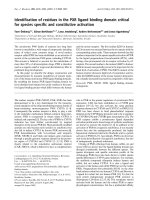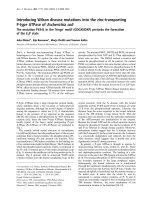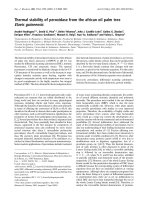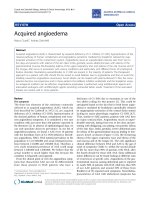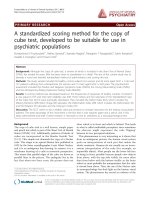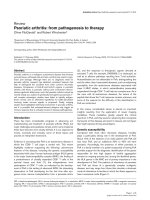Báo cáo y học: "This Provisional PDF corresponds to the article as it appeared upon acceptance. Fully formatted PDF and full text (HTML) versions will be made available soon." ppsx
Bạn đang xem bản rút gọn của tài liệu. Xem và tải ngay bản đầy đủ của tài liệu tại đây (10.24 MB, 15 trang )
This Provisional PDF corresponds to the article as it appeared upon acceptance. Fully formatted
PDF and full text (HTML) versions will be made available soon.
High resolution CT and histological findings in idiopathic pleuroparenchymal
fibroelastosis: features and differential diagnosis
Respiratory Research 2011, 12:111 doi:10.1186/1465-9921-12-111
Piciucchi S ()
Tomassetti S ()
Casoni G ()
Sverzellati N ()
Carloni A ()
Dubini A ()
Gavelli G ()
Cavazza A ()
Chilosi M ()
Poletti V ()
ISSN 1465-9921
Article type Letter to the Editor
Submission date 18 February 2011
Acceptance date 23 August 2011
Publication date 23 August 2011
Article URL />This peer-reviewed article was published immediately upon acceptance. It can be downloaded,
printed and distributed freely for any purposes (see copyright notice below).
Articles in Respiratory Research are listed in PubMed and archived at PubMed Central.
For information about publishing your research in Respiratory Research or any BioMed Central
journal, go to
/>For information about other BioMed Central publications go to
Respiratory Research
© 2011 S et al. ; licensee BioMed Central Ltd.
This is an open access article distributed under the terms of the Creative Commons Attribution License ( />which permits unrestricted use, distribution, and reproduction in any medium, provided the original work is properly cited.
/>Respiratory Research
© 2011 S et al. ; licensee BioMed Central Ltd.
This is an open access article distributed under the terms of the Creative Commons Attribution License ( />which permits unrestricted use, distribution, and reproduction in any medium, provided the original work is properly cited.
1
High resolution CT and histological findings in idiopathic
pleuroparenchymal fibroelastosis: features and differential diagnosis
Piciucchi S
1
, Tomassetti S
2
, Casoni G
2
, Sverzellati N
3
, Carloni A
4
, Dubini A
5
,
Gavelli G
1
, Cavazza A
6
, Chilosi M
7
, Poletti V
2
1. Department of Radiology, Scientific Institute for study and treatment of
Cancer-IRST; Via Piero Maroncelli 40-42; 47014; Meldola-Forlì; Italy
2. Department of Pulmonology; Morgagni-Pierantoni Hospital; Via Carlo Forlanini 34,
47121; Forlì; Italy
3. Department of Radiology; University of Parma; Via Gramsci 14; 43100; Parma, Italy
4. Department of Radiology; Santa Maria Hospital; Via Tristano di Joannuccio 1, 05100;
Terni, Italy
5. Department of Pathology; Morgagni-Pierantoni Hospital; Via Carlo Forlanini 34,
47121; Forlì; Italy
6. Department of Pathology; Arcispedale Santa Maria Nuova; Viale Risorgimento 57;
42100; Reggio Emilia; Italy
7. Department of Pathology; University of Verona; Piazzale A. Stefani 1; 37126; Verona;
Italy
Corresponding Author:
Corresponding Author: Corresponding Author:
Corresponding Author: Sara Piciucchi, MD
Dpt. Radiology
IRST, Scientific Institute for Treatment and Study of Cancer
Via Maroncelli 40-42 Meldola-Forlì
ABSTRACT
ABSTRACTABSTRACT
ABSTRACT
Idiopathic pleuroparenchymal fibroelastosis (IPPFE) is a recently described
clinical-pathologic entity characterized by pleural and subpleural parenchymal
fibrosis, mainly in the upper lobes. As this disease is extremely rare (only 7
cases have been described in the literature to date) poorly defined cases of
IPPFE can go unrecognized.
The clinical course of disease is progressive and prognosis is poor, with no
therapeutic options other than lung transplantation currently available, yet.
The aim of this report is to describe two further cases of this rare disease,
reviewing CT, clinical and histological features.
Letter to the Editor
Letter to the EditorLetter to the Editor
Letter to the Editor
Introduction
IntroductionIntroduction
Introduction
Idiopathic pleuroparenchymal fibroelastosis (IPPFE) is an entity characterized
by pleural and subpleural parenchymal fibrosis. It is extremely rare (only 7
cases have been described in the literature to date) and was first described in
2004 by the Interstitial Lung Disease Program of the National Jewish Medical
and Research Center of Denver [1].
Between 1996 and 2001, 5 cases were registered as cryptogenic syndrome with
significant chest symptoms, radiographic pleura-parenchymal abnormalities
and fibroelastotic changes seen on surgical biopsy specimens, without any
evidence of of other connective tissue disease, sarcoidosis, hypersensitivity
pneumonitis, infection or asbestosis [1].
Marked apical pleural thickening associated with superior hilar retraction is
present at chest X ray analysis, and High Resolution Computed Tomography
(HRCT) shows pleural thickening, fibrosis, architectural distortion, traction
bronchiectasis and honeycomb lung [2].
The clinical course of this affection is progressive and prognosis is poor, with no
therapeutic options other than lung transplantation currently available.
We here describe two further additional cases of this rare disease, reviewing its
high resolution and pathological features.
Case 1
Case 1Case 1
Case 1
A sixty-eight-year-old non-smoking man, ex-fishmonger, living in the
countryside, non-smoker, presented with a non-productive cough that he had
been bothering him for aboutpresent for three years. Nine years
previouslyearlier, the patienthe had been treated for gastric cancer, with
negative follow-up. No clubbing or other respiratory signs were observed upon
physical examination andLung functional exams were as follows: FVC 2.74 L-
78%; FEV1: 99% and DLco 67%. No O2-desaturation during the a 420 m walk
test 420 m was observed, with a final pO2 saturation of 96mmHg . Serological
examination did not identify anyidentified no signs of immunological
/rheumatologic or rheumatologic disorders. CT scan (Figure 1) showed bilateral
fibrotic changes, mainly representedprimarily in the upper lobes. Interlobular
septal thickening, mild honeycombing and moderate pleural thickening were
also seen. CT scan was also evaluated blindly by two chest radiologists, with
the initial suspicion of a possible idiopathic pulmonary fibrosis. Two
independent chest radiologists They reported a non-typical pattern of usual
interstitial pneumonia (UIP), mainly due to the the absence of a caudocranial
gradient. However, the main localization of the abnormalities was in the upper
lobes, which was is more consistent with chronic hypersensitivity pneumonitis
(HP). The patient underwent bronchoalveolar lavage which showed presence
of 11%: lymphocytes 11%, % and 2% neutrophils 2%, and no eosinophils were
seen. A transbronchial biopsy was performed too, but unfortunately
nondiagnostic. As radiological and histological patterns were not suggestive of
pulmonary fibrosis and did not meet American Thoracic Society criteria, open
lung biopsies (Video-Assisted Thoracoscopic Surgery) were performed on the
dorsal segments of the right upper and lower lobes, showing and showed
histological features of idiopathic pleuroparenchymal fibroelastosis (IPPFE) (Fig.2).
Unfortunately we weren’t able to study the evolution of pleuroparenchymal
abnormalities in the years before, because of the lack of prior CT scans. Actually
patient underwent just chest X rays.
Case 2
Case 2Case 2
Case 2
In a separate case, aA 28-year-old non-smoking man, plumber, non smoker,
with suspected professional exposure to asbestos, presented in 2004 with a
cough, vomiting and muscular asthenia. Serological exams showed positive
precipitins for Aspergillus and birds. Moreover, a fFunctional respiratory tests
showed an important signs of restrictive syndrome disease associated with a
severe substantial reduction in DLCO. , and Cchest X rays revealed interstitial
prominence in apical lung zones and pleural thickening. High resolution CT
scan (Fig. 3) showed a numberpresence of calcified plaques, without upper or
lower lobe predominance, maybepossibly due to asbestos exposure. , and
Significant fibrotic thickening of pleural margins and of fissures were seen in
both upper lobes. Moreover, aAlso, a reticular pattern due toassociated with
mild interlobular septal thickening, especially in apical subpleural regions, was
observed. , but with no honeycombing or pleural effusion. Even though pleural
plaques were related to pneumoconiosis, asbestosis asbest exposure did not
justify explain all the radiological findings, especially not the fibrotic thickening
of the pleura of the subpleural region in the upper lobes. For this reason, the
patient underwent a transbronchial biopsy which did not show ferruginous
bodies. . An open lung biopsy was subsequently performed on the dorsal
segment of the right upper and lower lobes, showing histological features
compatible with IPPFE (Fig.4).
Histopathology
HistopathologyHistopathology
Histopathology
In both cases described in this letter, the histology corresponded to that
previously described for IPPFE [1,2]. Visceral pleura was diffusely and markedly
thickened by a mixture of elastic and dense collagen fibers, with sparing of
adjacent lung parenchyma (Fig. 2 and 4). Although the transition from
fibroelastosis to normal parenchyma was abrupt, elastic fibers variably
extended to adjacent alveolar walls. Some fibroblast foci were observed in both
cases covered by alveolar epithelium at the boundary between the fibroelastosis
and normal parenchyma. Scattered alveolar structures were covered by
cuboidal type-II pneumocytes, as defined by the immunohistochemical
expression of cytokeratin 8/18 and surfactant-protein-A, were entrapped within
the fibroelastotic subpleural tissue, together with numerous vessels, including
podoplanin-expressing lymphatic vessels (Fig. 2A and 4B).
Discussion
DiscussionDiscussion
Discussion
Idiopathic pleuroparenchymal fibroelastosis (IPPFE) is a relatively
novelrecently described entity characterized by marked pleural and sub pleural
fibrosis, with main presentation typically in the upper lobes. In this letter
In our report, the first patient described showed honeycombing in the upper
lobes, which is not suggestive of UIP. We considered the possibility of HP
because of the prevalence of fibrotic changes in the upper lobes and of the mild
exposure of the patient to countryside antigens. However, in a retrospective
revision as the predominant pattern was thickening of pleural and subpleural
parenchyma, HP was ruled out. The second patient’s exposure history initially
pointed towards asbestosis. , butHowever, transbronchial and open lung
biopsies did not reveal any ferruginous bodies. , and Moreover, therepeated
radiological radiology appearance showed showed complete stability of
findings over five years (from 2004 to 2008). According to literature and to our
observation, IPPFE could be considered as to express two aspects of the same
entity: a sporadic form, prevalent in male patients and a familiar form, mainly
in young women in whom the disease is more aggressive and the prognosis is
poor [1-4]. On the basis of this distinction and on the stability of follow-up, the
second patient showed features of the sporadic form.
The differential diagnosis of IPPFE includes affections with this relatively rare
combination of both pleural and parenchymal fibrosis. Particularly it includes:
asbestosis, connective tissue diseases, advanced fibrosing sarcoidosis and
radiation or drug induced lung disease.
In addition, a number of histological features can overlap with those of nonspecific
interstitial pneumonia (NSIP) and usual interstitial pneumonia UIP,
where elastic fibers can be abnormally increased.3 However, the fibroelastosis
observed in IPPFE is especially pronounced and extends to alveolar walls. In
addition, upper lobe predominance and sparing of adjacent parenchyma lung
marks this disease as a entity.In routine chest X-rays it is quite common to
report bilateral apical thickening of the pleura, especially in adult patients or
when there is a clinical history of parenchymal infections. A careful overview
evaluation of respiratory status and infectious history could be useful in cases
of this rare parenchymal disorder.
Features of IPPFE may overlap with that observed in other disorders that
mainly involve the upper lobes (Fig.5): chronic hypersensitivity pneumonitis and
apical caps.
In hypersensitivity Pneumonitis (HP) the lesions are bronchiolocentric and
bronchiolization of the centrilobular airways is prominent.
Apical caps may be a difficult morphological differential diagnosis and
probably the difference in mainly quantitative being the lesions less prominent
in apical caps. Differential diagnosis could be often reached on the basis of
clinical and radiological features. IPPFE is an interstitial lung disease in
opposite to apical cap [2,3].
It needs to be underlined, that probably IPPFE is probably, as far as we know, a
not specific morphological reaction that might be associated to different causes
or settings. In the histological setting, a last differential diagnosis may be done
also with findings observed in emphysematous scars, particularly at the apex of
smokers and COPD. Actually, in smoking related fibrosis, a ialine fibrosis
surrounding subpleural and centrilobular emphysema can be seen. These
findings were not evident in our cases. Moreover our patients didn’t smoke.
In conclusion, the possibility of IPPFE should be considered when
radiological evidence is not consistent with well-defined idiopathic pneumonias
that affect upper lobes.
Competing Interests
Competing InterestsCompeting Interests
Competing Interests
We confirm that none of the authors have any conflicts of interest to declare.
Consent
ConsentConsent
Consent
Written informed consent was obtained from the patient for publication of this case
report and accompanying images. A copy of the written consent is available for review by
the Editor-in-Chief of this journal.
References
ReferencesReferences
References
1. Frankel SK, Cool CD, Lynch DA, Brown K. Idiopathic pleuroparenchymal
fibroelastosis: description of a novel clinicopathologic entity. Chest 2004;
126:2007-2013.
2. Becker CD, Gil J, Padilla M. Idiopathic pleuroparenchymal fibroelastosis:
an unrecognized or misdiagnosed entity? Mod Pathol 2008; 21:784-787.
3. Rozin GF, Gomes MM, Parra ER, Kairalla RA, de Carvalho CR, Capelozzi
VL. Collagen and elastic system in the remodelling process of major types
of idiopathic interstitial pneumonias (IIP). Histopathology 2005;46:413-
421.
4. Azoulay E, Paugam B, Heymann MF, eta l. Familial extensive idiopathic
bilateral pleural fibrosis. Eur Respir J 1999;14:971-973
Figure legends
Figure legendsFigure legends
Figure legends
Fig. 1. High resolution CT scan in patient no. 1 shows severe pleural and
subpleural thickening with moderate fibrotic changes in the marginal
parenchyma. Traction bronchiectasis and honeycombing are also seen.
Fig. 2. Histological features of patient no. 1. Marked subpleural thickening
characterized by abnormal increase of elastic fibers and abrupt transition to
normal parenchyma is evident at low magnification (2A and B). A number of
residual alveolar structures are entrapped within the thickened pleural wall
together with numerous lymphatic vessels (2c-e, podoplanin
immunohistochemistry).
Fig. 3. High resolution CAT scan in patient no. 2 shows pleural thickening.
Fig. 4. Histological features of patient no. 2. Marked subpleural thickening can
be observed with sparing of adjacent lung parenchyma (4A). Fibroblast focus
(ff) covered by alveolar epithelial cells is highlighted at the boundary between
fibroelastic (4B, elastic stain) tissue and alveolar parenchyma (4C, cytokeratin
8/18 immunohistochemistry).
Fig.5. CT scan of apical region in both patients (a: patient n°1 and b: patient n°
2)shows a diffuse thickening of pleuroparenchymal interface, suggesting IPPFE.
